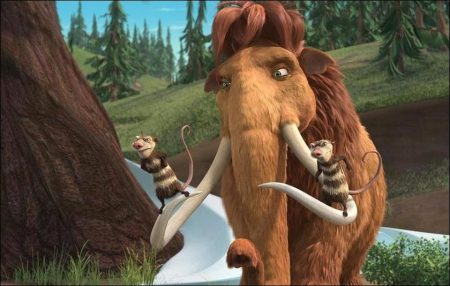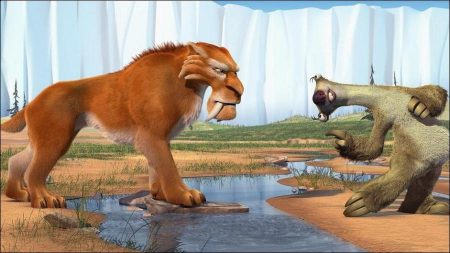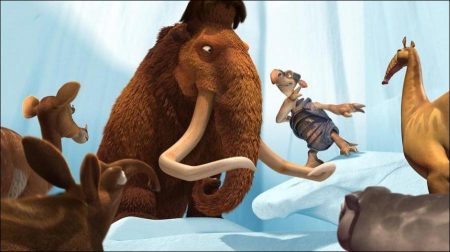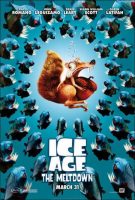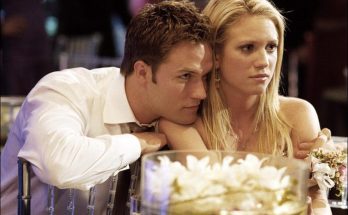Tagline: The chill is gone.
In Ice Age: The Meltdown, the sub-zero heroes from the worldwide blockbuster CGI film “Ice Age” are back – Manny the woolly mammoth, Sid the sloth, Diego the saber-toothed tiger, and the hapless prehistoric squirrel/rat known as Scrat. In the new film, from director Carlos Saldanha and the Academy Award winning creators of “Ice Age” and “Robots,” the Ice Age is coming to an end, and the animals are delighting in the melting paradise that is their new world.
Ray Romano, John Leguizamo and Denis Leary return to voice our three heroes: Manny, Sid, and Diego. New cast members include Academy Award nominee Queen Latifah (“Chicago”), Seann William Scott (the “American Pie” trilogy), late night talk show king Jay Leno, Will Arnett (“Arrested Development”) and Josh Peck (“Drake and Josh”).
Our trio is still together and enjoying the perks of their now melting world. Manny may be ready to start a family, but nobody has seen another mammoth for a long time; Manny thinks he may be the last one. That is, until he miraculously finds Ellie (voiced by Queen Latifah), the only female mammoth left in the world. Their only problems: They can’t stand each other – and Ellie somehow thinks she’s a possum!
Ellie comes with some excess baggage in the form of her two possum “brothers”…Crash and Eddie (voiced by Seann William Scott and Josh Peck), a couple of daredevil pranksters and cocky, loud-mouthed troublemakers. Manny, Sid, and Diego quickly learn that the warming climate has one major drawback: A huge glacial dam holding off oceans of water is about to break, threatening the entire valley.
The only chance of survival lies at the other end of the valley. So our three heroes, along with Ellie, Crash and Eddie, form the most unlikely family – in any “Age” – as they embark on a mission across an ever-changing, increasingly dangerous landscape towards their salvation. The film also presents the continuing adventures, or misadventures, of Scrat, who has an even larger role this time.
Ice Age: The Meltdown has everything you loved about the first movie with even more comedy, action, and spectacular visuals. Our three heroes’ unyielding friendship lives on with some memorable new characters thrown into the mix. The result will thaw hearts of all ages.
When the smart, character-based comedy “Ice Age” hit theaters in March 2002, critics and audiences immediately responded to its action, adventure, humor and heart. They fell in love with the four principal characters – three of whom unexpectedly come together to form a family, while the fourth begins his lifelong struggle to get his nut.
“The film’s success was largely due to the fact that audiences loved the characters,” says executive producer Christopher Meledandri, who also serves as president of Twentieth Century Fox Animation. “They bonded with Manny, Sid and Diego and laughed at Scrat.”
The film’s broad-based appeal was also aided by the starring voice cast – Ray Romano, John Leguizamo and Denis Leary – whose inherent edginess helped attract adults and teens. Even before “Ice Age’s” global theatrical and DVD successes, Meledandri, Carlos Saldanha, Chris Wedge (the first film’s director), and producer Lori Forte, knew there were more stories to tell for these characters. Unwilling to rest on their laurels, the filmmakers wanted to make the new film even funnier, richer, and a bigger visual experience than “Ice Age.” The new film’s big idea – the animals interacting with a melting world – would be made possible by specific technological advances from Blue Sky Studios, which made “Ice Age,” “Robots” and Ice Age: The Meltdown.
Again starting from a character base, the filmmakers, including Carlos Saldanha who had moved into the director’s chair (with “Ice Age” helmer Chris Wedge now an executive producer), considered the question, Where could the characters go from where we left them in the first film? They decided that each character would experience significant individual growth, helped along the way by their friends.
In “Ice Age,” Manny is dealing with the pain of having lost his family years earlier. In the new story, he wonders if he will ever find a family – or love – again. When he meets a female woolly mammoth, Ellie, he has hopes for something special to happen; alas, there are complications.
While Manny pursues romance, Sid, who in the first film was the target of everyone’s jokes and was never taken seriously, yearns for respect – and he just might get it. “Sid’s very insightful, especially about Diego,” says Saldanha. “He can see inside Diego’s head, somehow.” Diego, a once-fierce saber-toothed tiger, discovers he has a fear that gives him more than a little trouble in their new rapidly-melting world: he’s afraid of water. “Diego, a predator in `Ice Age’ is now part of this oddball family,” adds Saldanha. “He has that huge issue – his fear of the water – that Sid discovers.”
Perhaps the most challenging character for which to create a new story was Scrat, the prehistoric squirrel/rat who spent the first film chasing after a perpetually elusive acorn. Initially envisioned as having a small part in “Ice Age,” the character’s explosive popularity in the film’s first teaser trailer led the filmmakers to significantly expand his role.
For Ice Age: The Meltdown, the filmmakers were determined to explore new facets of Scrat. His singular focus remains on getting his cursed acorn, even as he continues to run into an endless series of obstacles. Saldanha, producer Lori Forte and some of today’s top comedy writers add new twists so Scrat remains as funny and fresh as he was in the first film.
“Carlos really stretched and pushed the character,” says Meledandri. “Scrat is still going after the nut, but his attitudes and expressions of frustration change. He becomes more integrated into the story – a big step forward for him.”
Meledandri says Saldanha’s abilities with physical humor are critical to the film. “His sense of humor extends beyond the verbal,” says Meledandri, “and animation is often at its best when it’s non-verbal. Carlos communicates so much through performance and physicality. He really understands the language of performance.” Adds executive producer Chris Wedge, who collaborated closely with Saldanha on “Ice Age” and “Robots”: “Carlos knows every aspect of this story and of these characters. He’s been at my side at Blue Sky Studios for ten years.”
Once the character perspectives were established, the filmmakers began to explore the story’s brave new world: the melting Ice Age. Says Chris Wedge: “With `Ice Age,’ we made the environment a major character. And the same thing happens in Ice Age: The Meltdown, but on an even bigger scale.”
Much of “Ice Age” was set against a backdrop of ice and snow. In the new film’s melting world, there’s room for other environmental dynamics and a warmer-looking landscape. “It was important that the visual experience be reflective of the first film, while also being distinct and fresh,” says Lori Forte. “The melting world is a big step forward in creating a new experience for the audience. It gave us a changing environment that becomes increasingly perilous for our characters. It really propels the action.”
Besides the “meltdown,” the film presents several environments new to the “Ice Age” universe, including trees, grass and mountains. The ever-changing landscape itself becomes a character – a kind of ticking-clock that counts down the peril as the characters try to flee to safety before the dam breaks and the valley floods.
To create Ice Age: The Meltdown’s new environments, the filmmakers utilized twice as many effects as they did for its predecessor. Since “Ice Age,” huge strides have been made at Blue Sky Studios in rendering fur and water. “The technology helps bring audiences into the story’s own `reality’ and transport them to this world,” says Meledandri. “They may not notice specific technical advances, but they will feel them – it will seem like you can reach out and touch the characters.”
The Original “Fab 4” Return
Ray Romano, John Leguizamo and Denis Leary welcomed their return to the world of “Ice Age.” “It was fascinating watching their processes for this film,” says Lori Forte. “For `Ice Age,’ they really didn’t know what they were getting into – or how it was all going to come out. This time around, everyone was much more confident; they just slid into their roles, effortlessly.”
Romano, who last year concluded a nine-year run on the smash series “Everybody Loves Raymond,” notes that the first film’s heart, humor and adventure appealed to adults as much as young people. He was particularly pleased that Manny’s story is again the emotional core. “Every time I watch `Ice Age’ and see Manny, I go, `That’s the big guy; the big guy that we love.
“I love Manny as a character, and I love playing him,” Romano continues. “His values and spirit are terrific. He’s a curmudgeon with a big chip on his shoulder and a tough exterior. But underneath that, he’s all warm and fuzzy – for a mammoth, at least.”
And how did Romano feel about Manny’s first attempts at romance? “Ellie gives Manny a twinkle in his eye. But unfortunately she’s a bit `off’, so it’s not smooth sailing. Though it was easy to make that work, because I was able to rely on my own lack of knowledge about talking to women,” he jokes.
“Actually, it was exciting to be in an on-screen romance,” he adds. “But I had to remind myself it’s an animated film, right? Queen Latifah, who voices Ellie, wasn’t even in the same recording booth as me!”
John Leguizamo was eager to explore new facets of Sid. “There was still unfinished business left over from `Ice Age’ that I was eager to get into,” says the actor, known for both his work in hit movies, like “Moulin Rouge!” as well as his provocative stand-up concert films. “I wanted to re-create that same lovable character but take him to another level.”
For “Ice Age,” Leguizamo had given Sid a lateral lisp, after learning that sloths store food inside their cheeks. For the new film, Leguizamo spent much time getting back to that distinctive voice, while continually finding ways to add new dimensions to the character. The actor pondered Sid’s principal dilemma. “He wants respect, to be taken seriously,” says Leguizamo. “That’s his quest.”
Sid’s path is closely tied to Diego’s, because, ironically, it’s Sid who figures out Diego’s fear and helps him deal with it. The filmmakers and Denis Leary worked hard on the character’s story arc, connecting it to Sid’s, and thus giving new dimensions to both characters. “Diego and Sid are like brothers,” says Leary, “and Manny’s the older brother.” Leary returns to voice Diego after co-creating, executive producing, writing and starring in the acclaimed series “Rescue Me,” which returns for its third season later this year.
Like Romano and Leguizamo, Leary found much to explore with his character in Ice Age: The Meltdown. “Ray Romano gets the films’ emotional moments, John the funny ones, but Diego makes it all happen,” says Leary. “Diego is still a leader – smart and strong, but he thinks he may be getting `soft’ because of his fear of the water.”
According to Carlos Saldanha, Leary is closely tied to his on-screen character. “It’s difficult to see Denis without seeing Diego, and vice versa,” says the director. “Denis’s edgy humor and sarcastic quality are critical to Diego’s `voice.'”
As much as audiences loved Manny, Diego and Sid – and the actors who voice them – the real breakout star of “Ice Age” was Scrat, whose squeaks, screams and other strange utterances happened to be voiced by that film’s director, Chris Wedge. Says the filmmaker, who is one of the founders of Blue Sky Studios: “Scrat as a character is like someone dancing in front of everyone wearing only his underpants. He’s just hapless.”
Wedge was delighted with the audience reaction to the character, while expecting even bigger laughs with the character’s expanded role in Ice Age: The Meltdown. “Audiences tuned into Scrat right away,” he says, “because everyone relates to an underdog. Now that we’ve given him new dimensions for the second film, we expect an even bigger response to Scrat.”
The New Members of the “Ice Age” Family
At the end of “Ice Age,” Manny, Sid, Diego had come together to form a family, albeit a dysfunctional one. In Ice Age: The Meltdown, the stakes are raised as the trio meets new characters – who may join them to create a new, larger family.
As Manny wrestles with the idea that he’s the last mammoth on earth, he meets Ellie, a female woolly mammoth. Now that he’s finally met a female mammoth, nothing can stand in the way of true love – except, perhaps, the fact that Ellie has identity issues: she thinks she’s a possum. According to Lori Forte, that creates an interesting and fun dynamic between the two characters. “You couldn’t just have Manny and Ellie come together and have them fall in love right away,” she points out. “The more conflict there is, the funnier it is.”
To differentiate Ellie from Manny, and give her a more feminine quality, the filmmakers gave her rounder shapes, less bulk, a fun hairdo and a lighter, reddish color tone. Saldanha and the animators created a strong physical dynamic between Manny’s laconic style and Ellie’s more frenetic personality.
In casting Ellie, the filmmakers searched for a voice that was rich with personality – not just an actress with a big personality. “We had to consider how she would sound opposite Ray Romano,” says Saldanha. “In addition, we wanted someone with a voice that had strength, independence, empathy and humor. Queen Latifah embodied all these qualities.”
Latifah, who makes her animated feature film debut in Ice Age: The Meltdown, enjoyed exploring Ellie’s “complications.” “Ellie is just the sweetest, lovable lump that you’ve ever seen. But she’s…well…she’s a little strange. A little aloof. And a little confused about her identity. You see, Ellie thinks she’s a possum. But she’s really a woolly mammoth. That’s real confusion!”
The actress/musician has had several on-screen romances, but none compare to the stakes in Ellie’s relationship with Manny. “Manny thinks he’s the last woolly mammoth on earth, until he meets Ellie,” she explains. “There’s a potential to save the species, if only Ellie would realize who she is: a mammoth, and not a possum.”
Latifah says her background as a hip hop artist was a big factor in helping her create a voice performance for Ellie. “I think one of the reasons I enjoyed working on this film was because of the innate vocal rhythm I have as a musician. You catch things off that rhythm and you hear things a bit differently. So it was interesting for me to get Ellie’s vocal inflections and make sure they worked for the character.”
Joining Ellie on her journey are her two “brothers,” possums Crash and Eddie. They are wild and crazy – daredevils and pranksters – whose charm comes out of their love for and protectiveness toward their sister Ellie. Seann William Scott, who starred as the incorrigible `Stiffler’ in the “American Pie” trilogy, voices Crash, and Josh Peck, from Nickelodeon’s hit series “Drake and Josh,” voices Eddie.
Saldanha says that, individually, Scott and Peck are “free spirited, funny, and high-energy actors. Together, they produced magic,” which Saldanha captured by putting them together in the recording booth – a rarity in animated feature filmmaking.
The director drew special pleasure from animating Crash and Eddie because they’re so physically flexible and very different from Manny, Sid and Diego. That bendy physicality adds to the characters’ madcap fun. “Crash and Eddie will try any stunt – the crazier, the better,” says Saldanha. “They’re no-holds-barred in actions and humor, and that gives a director and animator so much to work with.”
Seann William Scott had not yet seen “Ice Age” when he committed to Ice Age: The Meltdown. But when he did catch up with the film, he was hooked. “The ICE AGE : THE MELTDOWN script was fun and I was looking forward to being a part of it,” he says. “But when I saw `Ice Age’ on DVD, it took the experience to a whole new level.”
Josh Peck is another “Ice Age” fan. “I loved how the emotions and character expressions came across in the film,” he says. “Watching it was like spending time with your best friends.”
Peck likens Eddie to a high-energy teenager. Still, he’s less intense than older brother Crash. “Of the two,” adds Peck, “Eddie’s the voice of reason, but he’s still a stunt devil who likes to have a good time – and take care of his sister.”
The film’s principals are supported by a menagerie of colorful villainous characters. Fast Tony, an armadillo voiced by late night talk show king Jay Leno, is a slick con artist who warns the valley creatures of the impending flood – and does everything he can to make a buck out of it. “I had a great time voicing Fast Tony,” relates Leno. “He has the amazing energy – and scruples – of a high-powered used car salesman. He’ll take anything, even a potential cataclysm, and use it to his advantage.”
Leno, a renowned stand-up comedian as well as talk show titan, likens the process of voicing an animated character to doing stand-up. “In both, you’re trying to make people laugh, using only your voice. If [voicing a character] was modern interpretative dance, I’d be in trouble,” he jokes. “But as a comic who’s used to being on stage, projecting, and making funny noises – I could handle the work on Ice Age: The Meltdown.”
A more threatening presence is the Lone Gunslinger Vulture, voiced by Will Arnett, who stars in the Emmy®-winning sitcom “Arrested Development.” The winged predator sees the flood as a golden opportunity: every creature in the valley becomes a potential meal! The banquet the vulture believes awaits him, inspires him and an entire chorus of vultures to song – an inventive take-off of the classic tune, “Food, Glorious Food,” from the ’60s Broadway musical (and Oscar-winning film) “Oliver.”
Then, there are the most dangerous creatures of all: Cretaceous and Maelstrom, two prehistoric reptiles who, once defrosted from their Ice Age habitat, chase our heroes with intent to devour. They’re a looming threat throughout the story. Cretaceous is a crocodile-like creature with a long snout, and Maelstrom is somewhere between a killer whale and a Tyrannosaurus Rex.
Production Details
Acclaimed artist/ character designer Peter de Sève, who designed the characters for “Ice Age,” returns for Ice Age: The Meltdown. Having been an instrumental force in the making of the first film, he was delighted to revisit his original creations and create several new characters. Ellie was a particular new favorite. “I’m excited about having a strong, interesting female character become part of this world,” says de Sève, “because we didn’t have one in the first film. Ellie is smart, eccentric and really knows who she is – despite her identity issues!”
To create designs for possums Crash and Eddie, de Sève studied other kinds of rodents, including prairie dogs and meerkats. He designed Crash and Eddie to be tubular-shaped, and gave them as much flexibility in their movements as possible. Some of the other new characters de Sève created for Ice Age: The Meltdown were designed for the first film but never used. “I was dying to get bird characters in this movie,” says de Sève. The designer got his wish with Lone Gunslinger Vulture, condors, and other winged creatures.
Even Manny, Sid and Diego got a bit of a design overhaul. “I always had in mind they would grow as characters and evolve as personalities and in their look,” says de Sève. “We gave them subtle improvements but couldn’t do major retooling because their looks had been established in `Ice Age.'”
De Sève worked closely with the modeling department, headed by Mike Defeo and Shaun Cusick, to continually fine-tune these and other characters. Defeo and Cusick and their team used new technologies to subtly rework Manny, Diego and Sid. First, they created clay models – perfect three-dimensional representations of the characters that were scanned into computers, creating a digital 3-D version of the sculpture.
Next came the rigging, which puts all the bones and moves on the characters, and sets up skeletal structures, musculatures, facial expressions, and controls for jaw, brow and eyelids. According to rigging supervisor Mark Piretti, several characters presented interesting rigging challenges. For example, Ellie’s big shock of hair, which hangs down close to her eyes, had the riggers developing a new hair-shaping system.
The layout department, headed by Arden Chan and Robert Cardone, provided continuity from shot to shot, making sure the show flow was working. They would often set up a scene in 3-D, which enabled the animators to know exactly what the shot should look like.
The animation department, led by three animation supervisors – James Bresnahan, Galen Tan Chu and Michael Thurmeier – dealt with anything that moved – the characters and, sometimes, even the camera.
There were 60 animators on Ice Age: The Meltdown, up from 35 on the first film. The increased staffing reflected the new film’s more sophisticated effects, increased scale, and sheer volume of work. Says Galen Tan Chu: “We preserved the characters from `Ice Age’, putting them onto a new model, with more advanced technical controls, which could articulate the characters in exciting new ways. This film’s definitely on another level from the first one.”
The animators played a crucial role in creating the characters’ performances, a fact not lost on Ray Romano. “We actors who voice the characters get a lot of credit for emoting, but it’s really the animators,” says Romano. “After a screening of `Ice Age,’ one of the writers on `Everybody Loves Raymond’ got caught up in the emotion of the picture, and said to me, `Ray, you were very good in the picture.’ Of course, so much of the emotion and performance come from the animators, who worked years on the film.” But Thurmeier gives due credit to the actors. “They inspire us tremendously,” he says. “A lot of what they provide is pure gold for the animators.”
Two of the new favorites for the animation team were Crash and Eddie, the hyper-active possums with a penchant for daredevil antics. “Everyone couldn’t wait to get their hands on Crash and Eddie,” says lead animator David Torres. “They’re like Scrat – you can do anything with them because of their high-energy physicality.”
The animators offer quick character animation highlights: “Manny’s all about the eye rolls and how you pose the brows and how fur covers a part of his face.” Adds David Torres, who spent much of the production animating Diego: “Diego has great range and energy because he’s a tiger. We made a few subtle changes from the first film – his eyes are closer together and more cat-like, and we made him more playful and less menacing; but he’s still much the same, and his sarcasm remains intact.” And Sid? “He isn’t super-subtle in his personality,” says Chu, `but he has subtle little movements in how he carries his weight, shifts his hips, and holds his arms. He’s always kind of semi-hunched.”
Scrat undergoes some of the biggest character-based changes. He’s still chasing the nut but the filmmakers have added new dimensions to his antics. In one scene, where he’s chased by a small army of snapping piranha, Scrat goes into Bruce Lee mode, displaying virtuoso martial arts moves that leave the deadly fish down and out.
As the animators were helping to create the character performances, the materials group, headed by Michael Eringis, was busy defining the look of the film’s surfaces, including skin, tusks, eyes and fur color. The materials group also worked on environmental surfaces, coming up with cool looks for ice, glaciers, rocks and trees – and creating subtle but important details like adding wear to the edges of rocks and trees.
Effects and New Technology
Blue Sky Studios, the home of “Ice Age,” “Robots,” the Oscar-winning short “Bunny,” and now Ice Age: The Meltdown, is renowned for its proprietary software CGI Studio™, recognized as the industry’s best Ray Tracing program; Ray Tracing creates unique lighting scenarios, such as the way light scatters off the creatures’ fur, with every piece of hair casting shadows. For Ice Age: The Meltdown, Blue Sky takes its groundbreaking technology to new levels, specifically in the rendering of fur and water.
Led by Fur and Feathers Supervisor Eric Mauer, the Blue Sky scientists rewrote existing fur rendering technology to create a subtle but important new look for the creatures. Instead of drawing hairs directly onto a character – as had been done on “Ice Age” – Mauer and his team used a Voxel (cube) rendering system, which actually renders the volume of the fur.
The resulting look was stunning: Manny, for example, has two million individually rendered hairs on his back. It’s the same Manny we know and love – but looking better than ever. “The fur becomes a character within a character,” says Carl Ludwig, a Blue Sky founder and the film’s research and development director. “It looks like real fur. Not only does it have a richness and sheen, it’s completely self-shadowing, which let us detail that little dark area between the hairs.”
Scrat also gets a fur makeover. Says Mauer: “The big improvement is in his tail. In `Ice Age’ it looked like a big balloon; now, it looks real, like a squirrel’s tail.” Adds Chris Meledandri: “Seeing the fine hairs on Scrat’s tail, and his nose quivering, adds a realistic feel to the character. You know, intellectually, that his character doesn’t exist. But you see this kind of detail and realism, your disbelief is suspended.”
The Fur and Feathers team worked similar magic on the feathered characters, including vultures, condors and diatrimo (prehistoric emu). But instead of drawing millions of hairs, the team drew millions of little barbs that grew off a quill to define each feather.
The new technology enabled the filmmakers to apply dynamic simulations, like wind and water, to the fur and feathers. Water, of course, was particularly important, because the characters exist in a melting world. The team had to create myriad looks for the fur, for various degrees of wetness – from a light splash to total immersion.
As they did with the fur, the filmmaker took water-character interaction to a new level – no easy feat because CG water simulation is extremely difficult and time-consuming. Says Effects Supervisor Robert V. Cavaleri: “Most animated features, like `Finding Nemo’ and `A Shark’s Tale,’ are set mostly underwater, so there’s not much character interaction with the water. In Ice Age: The Meltdown, we have the characters spending much of the film interacting with water: splashing on the surface, swimming, and diving.”
In the film, water, like fur, becomes a character, itself. To accomplish that, the filmmakers created a system in which splashes of water could be “directable,” which enabled the filmmakers to move water around like they would a flesh-and-blood character. “Giving the water this added character-like dimension makes it seem more threatening, adding to the film’s overall sense of peril,” says Cavaleri.
Art Director Thomas Cardone was another key contributor to creating the look of the film’s perilous, melting environment. Cardone began his work by studying “Ice Age’s” designs and what made them work so effectively. “`Ice Age’ had a wonderful simplicity,” says Cardone. “If that film was fall into winter, then Ice Age: The Meltdown is winter into spring.”
Cardone established a visual language based on color, lighting and shapes. The foundation of this language was a “color script” or palette he used through production. “Color creates certain emotions, and supports and enhances the story,” he says. “Ultimately, all this detail, which is often subtle, is intended to enable audiences to become lost and immersed in this world.”
The Sounds of the Meltdown
As work began to wind down on the production phase, the post-production process – including editing (Harry Hitner is the editor), scoring and sound design – was in full swing. During this phase, John Powell’s (“Shrek,” “Robots”) rich musical score was fully integrated with Randy Thom’s (“War of the Worlds”) sound design.
Thom, who works at Skywalker Sound, says his biggest challenge was maintaining a level of menace throughout the film. He elaborates: “In the story, there’s a gradually melting ice dam that threatens to flood the valley and its creatures. I had to evoke the sound of the dam’s gradual disintegration throughout the film, even though the glacier is mostly off-screen most of the time.”
Thom created a theme for the melting dam by merging two distinct sounds: one he created by cracking and twisting ice in pans, then treating that electronically to make an even bigger sound. Thom combined that with recordings of frozen rivers and lakes breaking up. “Frozen lakes leave a strange kind of `pinging’ sound when they begin to crack – kind of like a sonar blip noise,” he explains. “It’s a familiar sound to those who spend time around frozen lakes, but to others it could sound `science fiction-y’. So we combined the `sonar’ sound with the more familiar ice pan-cracking sound to create our melting-dam theme.”
Thom’s sound design for Cretaceous and Maelstrom broke new ground in creature sounds. Thom used whale sounds, which he crafted and combined with sounds of tigers on the attack, as well as a sinister human-voice element. “The human voice sounds provided us with dramatic and emotional controls over the sound that would not be possible had we been restricted to animal sounds.”
Ice Age: The Meltdown represents the work of hundreds of filmmakers, artists, scientists, technicians, and crafts people. Under the direction of Carlos Saldanha, and guidance from producer Lori Forte and executive producers Christopher Meledandri and Chris Wedge, they have created a film they hope will not only re-introduce audiences to the beloved heroes from “Ice Age,” but bring to them an even more fun, exciting and bigger world. “We wanted to create an experience that is more than a continuation of the story we began in `Ice Age’,” says Saldanha. “So we took our characters in new directions, upped the emotional stakes and comedy, and set our story against an even more dramatic backdrop.”
Ice Age: The Meltdown (2006)
Directed by: Carlos Saldanha
Starring: Ray Romano, John Leguizamo, Denis Leary, Queen Latifah, Seann William Scott, Josh Peck, Jay Leno, Will Arnett, Chris Wedge, Peter Ackerman, Caitlin Rose Anderson
Screenplay by: Jon Vitti
Cinematography by: Craig Grasso
Film Editing by: Harry Hitner
Art Direction by: Thomas Cardone
Music by: John Powell
MPAA Rating: PG for some mild language and innuendo.
Distributed by: 20th Century Fox
Release Date: March 31, 2006
Views: 86
